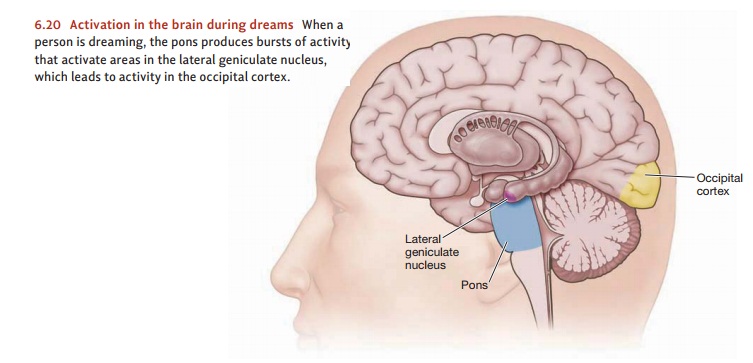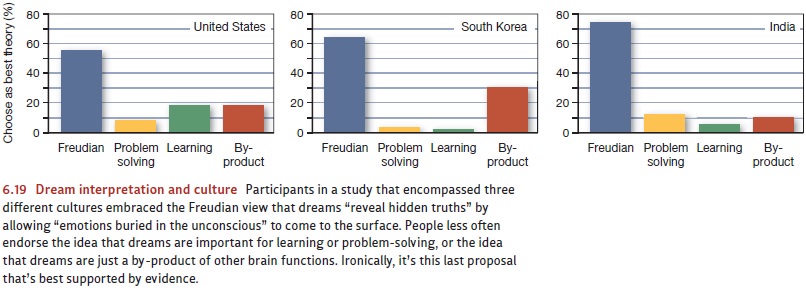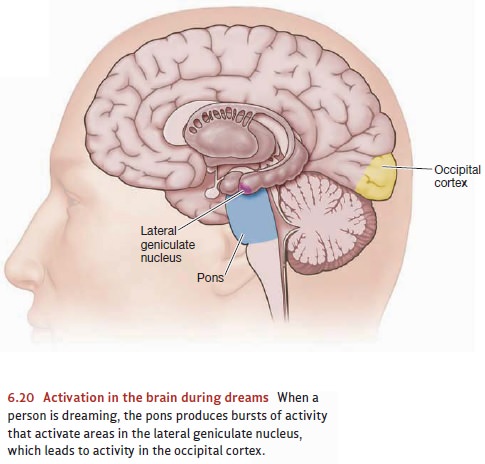Chapter: Psychology: Consciousness
Why Do We Dream ?

WHY DO WE DREAM ?
In Western cultures, dreams have
historically been considered prophetic; across the centuries, dream analysis
has been a standard practice among fortune-tellers. Moreover, people around the
world regard their dreams as meaningful.
In one study, people in countries as diverse as the United States, India, and
South Korea said they thought dreams “reveal hidden truths” by allowing
“emotions buried in the unconscious” to come to the surface (Figure 6.19;
Morewedge & Norton, 2009).

Apparently, then, people are
ready to endorse a proposal similar to the one suggested by Sigmund Freud in
his book, The Interpretation of Dreams
(1900). Freud argued that we all harbor a host of primitive and forbidden
wishes, but we protect ourselves by keeping these wishes out of our conscious
thoughts. In dreams, however, our self-censorship is relaxed just a bit,
allowing these impulses to break through into our awareness. Even in sleep,
though, some of our efforts at self-protection continue; so the forbidden
impulses can enter our dreams only in a disguised form. In Freud’s view,
therefore, the characters that we observe in our dreams, and the actions we
witness, are merely the manifest content
of the dream—the content we’re able to experience directly. The real meaning of
the dream, in contrast, lies in the dream’s latent
content—the actual wishes and desires that are being expressed
(symbolically) through the manifest content.
Is this proposal correct? At the
most general level, Freud is suggesting that dreams usually reflect the
sleeper’s ongoing emotional concerns; and he was surely correct about this
broad point. Thus if you’ve narrowly avoided a car crash, you’re likely to
dream about collisions and other accidents; if you’re worried about an upcoming
exam, you may well end up dreaming about exams or other forms of evaluation.
Indeed, in the weeks following the September 11, 2001, attacks, many residents
of New York City reported dreams about terrorist attacks (Galea et al., 2002).
There is, however, little
evidence to support Freud’s more ambitious claim that dream content should be
understood in terms of thinly disguised wishes (S. Fisher & Greenberg,
1977, 1996). As one large concern, Freud’s own evidence was based on his interpretation of dreams, and it’s
difficult (some would say impossible) to know if theinterpretations were
correct or not. There’s surely nothing inevitable about Freud’s
interpretations; indeed, some of his followers offered very different
interpretations of the same dreams that Freud himself had analyzed. This
highlights just how uncertain the interpretation process is, and it reveals
that the “evidence” Freud offered for his view is not persuasive in the way
science requires.
Modern scholars have therefore turned
to a different hypothesis about dream content, one that does not view dreams as
having a specific function of their own. Instead, dreams may be just a
by-product of other brain activities. Specifically, the activation-synthesishypothesis begins with the fact that during REM
sleep, the pons (a structure in the brainstem) produces bursts of neural
activity that in turn activate areas in the lateral genicu-late nucleus—an
important processing center for visual information. This activity then

leads to activity in the
occipital cortex—the brain area that carries out most of the analy-sis of
visual input. Researchers refer to this neural activity as PGO waves because it involves the pons, the geniculate, and
the occipital areas (Figure 6.20).
These waves are the “activation” part of activation synthesis and give us an
immediate explanation for why dreams are filled with vivid visual images—the
result of neural activity in brain areas ordinarily involved in processing
visual information.
But why do certain images come to
mind? The key here is that these brain areas have been primed by other neural
activity, activity caused by the person’s recent experiences as well as shaped
by their recurrent thoughts. It is therefore the combination of PGO activity
and this priming that brings certain images—either from the previous day or
reflecting broader themes—into awareness. There is, however, no orderly
narrative linking the images that come to mind; instead, the sequence is
essentially random. Still, the brain does what it can to assemble these images
into a coherent plot—this is the “synthesis” part of the activation-synthesis
hypothesis. Some of this assembly takes place during the dream itself, but some
probably occurs once the person is awake and trying to recall the dream.
Let’s be clear, though, that the
set of ideas activated in the sleeper’s brain is likely to be something of a
hodgepodge, since the sequence of these ideas is not constrained by perceptual
input or a cohesive set of goals. As a result, the effort toward coherence will
often be only partially successful, and this is why dreams are often
unrealistic: The shaky plot line is the best the brain can do in weaving
together the odd assembly of images that bubble into awareness during REM
sleep.
Other aspects of brain activity
also play a role in shaping dream content. Several studies have monitored the
pattern of blood flow through people’s brains while they were dreaming. The
data show high levels of activity in the limbic system, a set of structures in
the brain—including the amygdala—associated with perceiving and regulating
emotion; this result obviously fits with the emotional character of many dreams
(Schwartz & Maquet, 2002). The data also show considerable neural activity
in the motor cortex—as if the neurons were trying to initiate movements,
although other mechanisms (in the brain stem) intercept the signals from the
motor cortex and ensure the movements never occur. (This is why, as we
mentioned earlier, the body is impressively immobile during REM sleep.)
Brain scans also show diminished activity during sleep in some
brain areas. These include the prefrontal cortex, a brain region often
associated with planning and intelligent analysis. This finding may give us a
further clue about why dreams often have peculiar content: When we’re in the
dream state, the parts of the brain needed to assemble the story elements into
an intelligible narrative aren’t fully engaged.
Related Topics